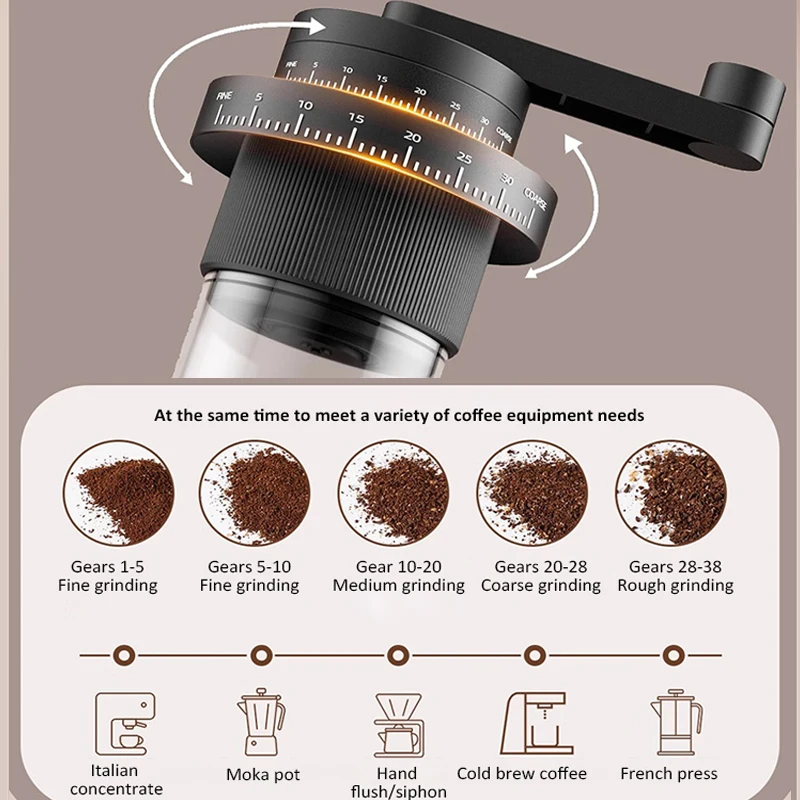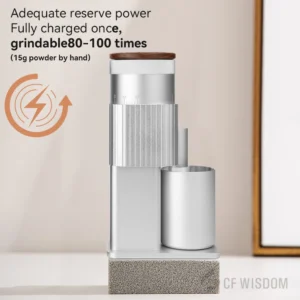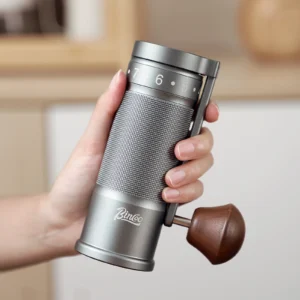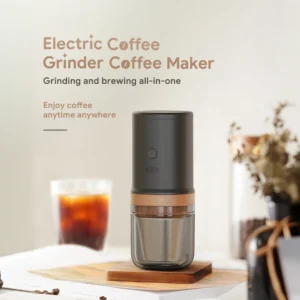Understanding the Small Kitchen Conundrum
Living with a small kitchen presents unique challenges, especially when you’re passionate about creating flavorful meals. The average apartment kitchen in urban areas measures just 70 square feet, with usable counter space often limited to 6-10 square feet. This premium real estate demands thoughtful consideration for every appliance that earns a spot in your culinary workspace.
While space constraints are real, the flavor difference between freshly ground ingredients and pre-packaged alternatives is equally undeniable. Studies consistently show that coffee begins losing 60% of its aromatic compounds within 15 minutes of grinding, while whole spices retain their essential oils and flavor compounds up to 4 times longer than their pre-ground counterparts.
For small kitchen dwellers, this creates a significant dilemma:
- How to incorporate quality grinding tools without sacrificing precious counter space
- Where to store specialty equipment in already-crowded cabinets
- Which grinding solutions offer the best balance of quality, versatility and compact design
- How to maximize flavor without maximizing kitchen clutter
This guide addresses these challenges head-on, helping you navigate the world of compact grinders to find solutions that enhance your culinary experience without overwhelming your limited space. Whether you’re a coffee enthusiast or a home cook who values freshly ground spices, understanding travel-friendly coffee grinding options will help you make informed decisions about incorporating these flavor-enhancing tools in your small kitchen setup.
Why Quality Grinding Matters in Limited Kitchen Space
The difference between pre-ground and freshly ground ingredients isn’t just noticeable—it’s transformative. When coffee beans are ground, they immediately begin releasing carbon dioxide along with hundreds of volatile aromatic compounds that create the complex flavors we love. Similarly, whole spices contain essential oils locked within their cell walls, protected until the moment of grinding.
In a small kitchen environment, this freshness factor becomes even more significant. While larger kitchens might accommodate numerous specialized appliances, compact spaces demand versatility and maximum value from each tool. A quality grinder delivers this value through:
- Flavor preservation: Grinding just before use ensures optimal taste whether you’re preparing coffee, spices, or herbs
- Customization: Different recipes require different grind consistencies—from fine powders for espresso to coarse textures for French press
- Ingredient flexibility: A versatile grinder eliminates the need for multiple specialized tools
- Economic efficiency: Whole ingredients typically cost less per ounce than pre-ground versions and stay fresh longer
For coffee specifically, proper grinding affects extraction dramatically. Uniform particle size leads to balanced flavor, while inconsistent grinding creates both under-extracted (sour, weak) and over-extracted (bitter) elements in the same cup. The essential features of compact coffee grinders include precision burrs and consistency mechanisms that ensure optimal extraction despite their smaller footprint.
In small kitchens where every inch counts, investing in a quality compact grinder represents a strategic choice—maximizing flavor while minimizing spatial impact, ultimately allowing you to enjoy freshly ground ingredients without sacrificing your limited workspace.
Essential Criteria: Choosing the Right Grinder for Your Compact Kitchen
When evaluating grinders for small kitchen spaces, specific criteria become particularly important. Understanding these factors will help you identify options that truly complement your limited space rather than compete with it.
Physical Dimensions and Storage Considerations
- Footprint measurements: Look for grinders under 5 inches (12.7 cm) in width to minimize counter space usage
- Height profile: Vertical designs can utilize height rather than width, fitting better under cabinets
- Storage-friendly features: Detachable handles, nesting components, or included storage cases maximize space efficiency
- Weight: Lighter options (under 2 pounds/0.9 kg) are easier to move between storage and use areas
Capacity and Efficiency
- Batch size appropriateness: 1-3 oz (28-85 g) capacity serves most small household needs without excess bulk
- Grinding speed: For manual options, consider that most quality hand grinders require 30-60 seconds for a single coffee serving
- Output consistency: Even in compact size, grind uniformity significantly impacts flavor quality
- Versatility: Multi-purpose capabilities eliminate the need for multiple specialized tools
Practical Considerations for Small Spaces
- Noise level: Compact living often means shared spaces—manual grinders operate at approximately 40-50 decibels versus 70-90 for electric models
- Cleaning requirements: Limited sink space demands easy-clean designs with minimal disassembly
- Power needs: Outlet availability may influence choice between manual and electric options
- Build quality: Durable construction justifies dedicated space in small kitchens through longevity
Understanding the differences between burr vs. blade coffee grinders becomes particularly relevant in small spaces, as each type presents different size, noise, and performance considerations. Burr grinders typically deliver superior consistency but may require more space, while blade grinders offer compact simplicity at the cost of grind quality.
These criteria provide a framework for evaluating the specific grinder types we’ll explore next, helping you identify which features matter most for your unique space constraints and culinary priorities.
Manual Grinders: The Space-Efficient Powerhouses
Manual grinders represent the ultimate space-efficient solution for small kitchens, combining compact dimensions with impressive grinding capability. These hand-powered tools typically occupy less than half the counter space of their electric counterparts while delivering comparable grinding quality.
Key Advantages for Small Kitchens
- Minimal footprint: Most premium manual grinders measure just 2-3 inches (5-7.6 cm) in diameter and 6-8 inches (15-20 cm) in height
- Outlet independence: No need for electrical connections, providing placement flexibility
- Silent operation: Critical in studio apartments or shared living spaces
- Dual-purpose potential: Many models serve both home and travel needs
- Precision grinding: Quality manual burrs often match or exceed electric grinders in consistency
The burr mechanism is where manual grinders truly shine. High-end portable manual grinders feature precision-engineered burr sets that deliver remarkably consistent particle size despite their compact dimensions. Ceramic burrs offer excellent longevity and won’t impart metallic flavors, while steel burrs provide superior durability and often produce more uniform results for coffee specifically.
Considerations for Manual Grinding
The primary trade-off is time and effort. A typical manual grinder requires approximately:
* 30-45 seconds for a single coffee serving (20g)
* 60-90 seconds for a double serving or espresso grind
* Moderate physical effort, though quality models with efficient mechanisms significantly reduce required force
For small batch spice grinding, this time investment is minimal, making manual grinders particularly suited for multi-purpose use in limited spaces.
Standout Space-Saving Manual Options
Premium manual grinders in the compact coffee mill category offer excellent performance-to-space ratios. Look for models featuring:
- Ergonomic handles that detach for storage
- Slim cylindrical designs that fit easily in drawers
- Catch cups that double as storage containers
- Consistent burr assemblies with minimal “popcorning” (beans jumping around before grinding)
The manual approach represents a natural fit for space-conscious kitchens, delivering freshly ground ingredients without the spatial compromise required by most electric alternatives.
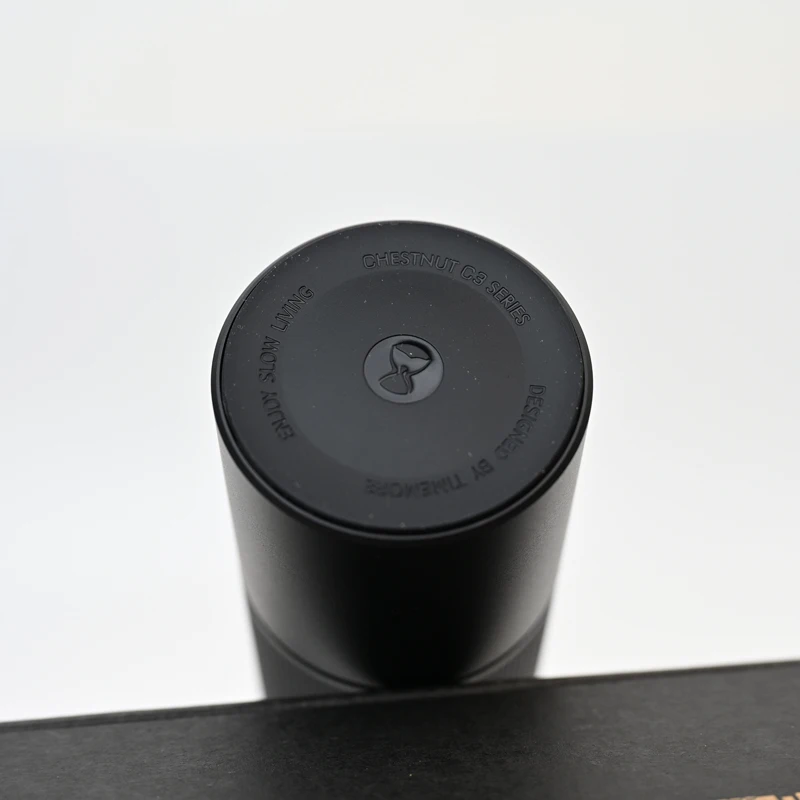
Compact Electric Grinders: Balancing Convenience and Space
Electric grinders present a different value proposition for small kitchens, offering speed and convenience while requiring thoughtful consideration of their spatial impact. The key is identifying models specifically designed with space efficiency in mind.
Space Considerations Unique to Electric Models
When evaluating electric grinders for compact kitchens, several factors become particularly important:
- True footprint assessment: Include space for cord management and clearance for lids/hoppers
- Height clearance: Many compact models are taller than wider, requiring sufficient vertical space under cabinets
- Storage logistics: Consider weight (typically 3-7 pounds/1.4-3.2 kg) and cord management when planning for between-use storage
- Multi-use potential: Some compact electric models offer attachments for different grinding purposes, maximizing utility per square inch
Mechanism Comparison in Compact Electric Format
In electric formats, the distinction between blade and burr mechanisms becomes even more significant:
Compact Blade Grinders:
* Typically smaller footprint (about 4×4 inches/10×10 cm)
* Less expensive ($15-40 range)
* Higher noise levels (75-85 decibels)
* Less consistent results, especially for coffee
* Often more versatile for different ingredients
Compact Burr Grinders:
* Slightly larger footprint (4×6 inches/10×15 cm average)
* Higher price point ($60-150 range)
* More consistent grinding results
* Often single-purpose (coffee specific)
* Generally quieter operation (65-75 decibels)
Heat generation becomes particularly relevant in electric models, as smaller motors can sometimes overheat with extended use. Quality compact options incorporate heat dissipation features to protect both the equipment and the flavor of ground ingredients.
For apartment dwellers, quiet travel-friendly grinders offer particular advantages, as they’re specifically engineered to minimize noise—a critical feature when grinding walls are shared with neighbors. These models typically operate at 65-70 decibels versus the 80+ decibels of standard electric grinders.
The ideal electric solution for small kitchens strikes a balance between minimal size, sufficient power, and appropriate versatility for your specific grinding needs.
Specialized Grinding Solutions for Different Ingredients
Different ingredients demand different grinding approaches, even in space-constrained kitchens. Understanding these specialized needs helps identify the most space-efficient solution for your particular cooking and brewing habits.
Coffee-Specific Considerations
Coffee grinding presents unique requirements that influence space-efficient grinder selection:
- Burr geometry: Conical burrs typically create slimmer profiles ideal for small spaces compared to flat burrs
- Grind range: Espresso requires 30-40 grind settings for precision, while basic brewing needs only 10-15 settings
- Static management: Compact grinders may generate more static, requiring features like anti-static coatings or metal construction
- Dose control: Single-dose grinders eliminate the need for bean hoppers, saving vertical space
The handheld coffee grinder category offers particularly space-conscious options for coffee enthusiasts, featuring streamlined designs that prioritize grinding quality in minimal dimensions.
Spice Grinding Requirements
Spice grinding presents different challenges in compact formats:
- Heat sensitivity: Many spices contain volatile oils damaged by heat, making manual grinders ideal
- Material considerations: Stainless steel or ceramic grinding surfaces prevent flavor transfer between ingredients
- Cleaning access: Thorough cleaning between different spices prevents flavor contamination
- Capacity needs: Typically smaller than coffee (5-15g vs. 20-30g), allowing for more compact designs
Herbs, Nuts and Seeds
These ingredients benefit from specific grinding attributes:
- Herbs: Require sharp cutting rather than crushing action to release aromatic oils without bruising
- Nuts/seeds: Benefit from variable texture control to achieve anything from fine flour to chunky pieces
- Oily ingredients: Require grinders with good cleaning access to prevent rancidity from built-up oils
Material selection becomes especially important for multi-purpose grinders in small kitchens. Ceramic burrs resist odor transfer between ingredients but may chip with harder materials. Stainless steel offers superior versatility but may require more thorough cleaning between uses.
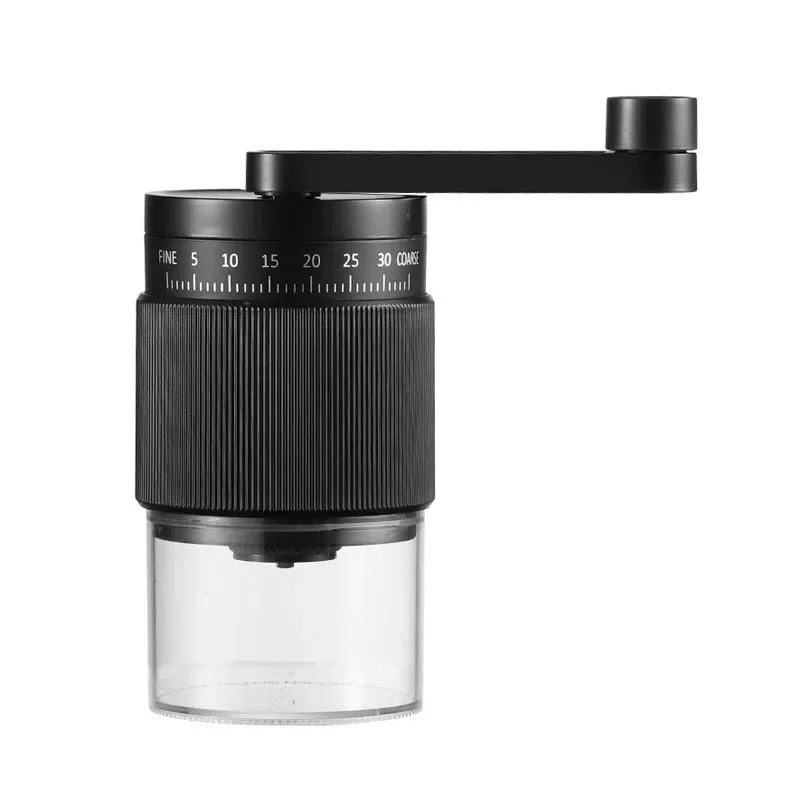
Top Space-Saving Grinders for Small Kitchens
When evaluating the most space-efficient grinders available today, our selection criteria focused specifically on models combining minimal dimensions with maximum performance. We prioritized options under 4 inches (10 cm) in width, excellent grind consistency, and versatile usage scenarios.
Premium Manual Burr Grinders
Manual burr grinders offer the smallest footprint while maintaining professional-grade grinding capability. Standout models in this category feature:
- Precision-machined steel or ceramic burr sets
- Ergonomic design for comfortable grinding
- Durable stainless steel or aluminum bodies
- Storage-friendly features like detachable handles
These portable coffee grinders deliver consistent results while occupying minimal space—many can be stored in a standard kitchen drawer when not in use. The finest models offer 15+ grind settings despite their compact size, allowing adjustment from fine espresso grind to coarse French press texture.
Space-Efficient Electric Options
For those prioritizing convenience, several electric models offer impressive space efficiency:
- Vertical-oriented designs with footprints under 5×5 inches (12.7×12.7 cm)
- Removable cord storage systems
- Direct-to-container grinding capabilities
- Multi-purpose grinding mechanisms suitable for coffee and spices
While these require more space than manual alternatives, they represent significant improvements over standard electric grinders, many of which are 50-70% larger.
Multi-Purpose Grinding Solutions
Some standout multi-functional options deliver particular value in space-limited kitchens:
- Convertible grinders with interchangeable burr sets
- Combo units with multiple grinding chambers for different ingredients
- Small food processors with dedicated grinding attachments
- Travel grinders with home bases for dual-environment use
Fine Adjustment Hand Grinder, Precision Manual Grinder, Travel Coffee Grinder
Price range: $185.11 through $494.63 Select options This product has multiple variants. The options may be chosen on the product pageHand Burr Grinder, Hand Crank Coffee Grinder, Manual Espresso Grinder, Portable Coffee Grinder
Price range: $262.72 through $300.22 Select options This product has multiple variants. The options may be chosen on the product pageManual Burr Mill, Manual Coffee Grinder Stainless Steel, Manual Coffee Mill Grinder, Mechanical Coffee Grinder
Price range: $127.26 through $130.32 Select options This product has multiple variants. The options may be chosen on the product pageHand Burr Grinder, Manual Coffee Grinder Stainless Steel, Precision Manual Grinder
Price range: $183.64 through $187.52 Select options This product has multiple variants. The options may be chosen on the product pageHandheld Burr Grinder, Manual Coffee Mill Grinder, Travel Coffee Grinder
$191.45 Select options This product has multiple variants. The options may be chosen on the product page
When comparing options across categories, consider how your primary grinding needs align with available space. A coffee enthusiast might prioritize burr quality in the smallest possible package, while someone who grinds various ingredients might benefit from a slightly larger multi-purpose solution that eliminates the need for multiple specialized tools.
Storage Solutions: Maximizing Your Grinder’s Place in a Small Kitchen
Creative storage solutions can further enhance the space efficiency of even the most compact grinders. Implementing these strategies helps integrate your grinding equipment into your limited kitchen landscape.
Vertical Storage Options
Utilizing vertical space provides storage without sacrificing limited counter or drawer area:
- Wall-mounted magnetic strips work well for metal grinders
- Narrow shelving units in underutilized spaces (beside refrigerators, above sinks)
- Cup hooks under cabinets for hanging compatible manual grinders
- Tension rods with S-hooks create adjustable hanging storage in cabinets
Integrated Storage Systems
Multi-functional storage solutions maximize efficiency:
- Coffee stations with dedicated grinder zones
- Drawer organizers with specific grinder compartments
- Pull-out cabinet shelves that bring grinders forward for use without permanent counter placement
- Nested systems where grinders store inside larger equipment when not in use
Protection Considerations
Proper storage extends grinder lifespan in small kitchen environments:
- Moisture protection in humid kitchens through silica gel packets
- Padding in tight drawers to prevent mechanism damage
- Dust covers for infrequently used equipment
- Vibration isolation from nearby appliances
Many users with limited space find that selecting grinders with ergonomic features for small hands also improves storage options, as these models typically feature more compact dimensions and thoughtful design elements that transition smoothly between storage and use.
The key to successful small-space grinder storage is identifying your usage patterns—daily grinders warrant accessible locations with minimal setup time, while occasional-use equipment can utilize more creative storage solutions provided they remain easily retrievable.
Maintaining Your Grinder in Limited Space: Cleaning and Care
Proper maintenance ensures longevity and consistent performance from your grinding equipment—especially important when you’ve invested in quality tools for a small kitchen. Streamlined cleaning routines help overcome the challenges of limited sink and counter space.
Space-Efficient Cleaning Methods
Adapt your cleaning approach to your spatial constraints:
- Use small brushes (repurposed makeup brushes work well) for precision cleaning without large sink areas
- Create a dedicated cleaning station on a small washable mat that can be set up and removed as needed
- Employ compressed air canisters for cleaning difficult-to-reach areas without disassembly
- Utilize ultrasonic cleaners (jewelry cleaners) for thorough cleaning of small metal parts
Quick Maintenance Routines
Develop habits that maintain grinder performance without consuming significant space or time:
- Weekly quick-clean regimen (2-3 minutes) using rice or grinder-cleaning pellets
- Monthly deep-clean schedule (10-15 minutes) with complete disassembly
- Keep a dedicated small toolkit for grinder maintenance to avoid searching for appropriate tools
- Store cleaning supplies in a compact container alongside your grinder
Understanding whether coffee grinders need maintenance is essential for preserving their performance in small kitchen settings. Regular maintenance prevents common issues like degraded burr alignment, handling buildup, and diminished grind consistency—all of which affect flavor quality.
For multi-purpose grinders, develop a cleaning sequence between different ingredients:
1. Grind a small amount of neutral material (bread cubes, rice) to absorb residual oils
2. Brush or wipe accessible surfaces
3. Run a small amount of the new ingredient through and discard it
4. Proceed with your actual grinding needs
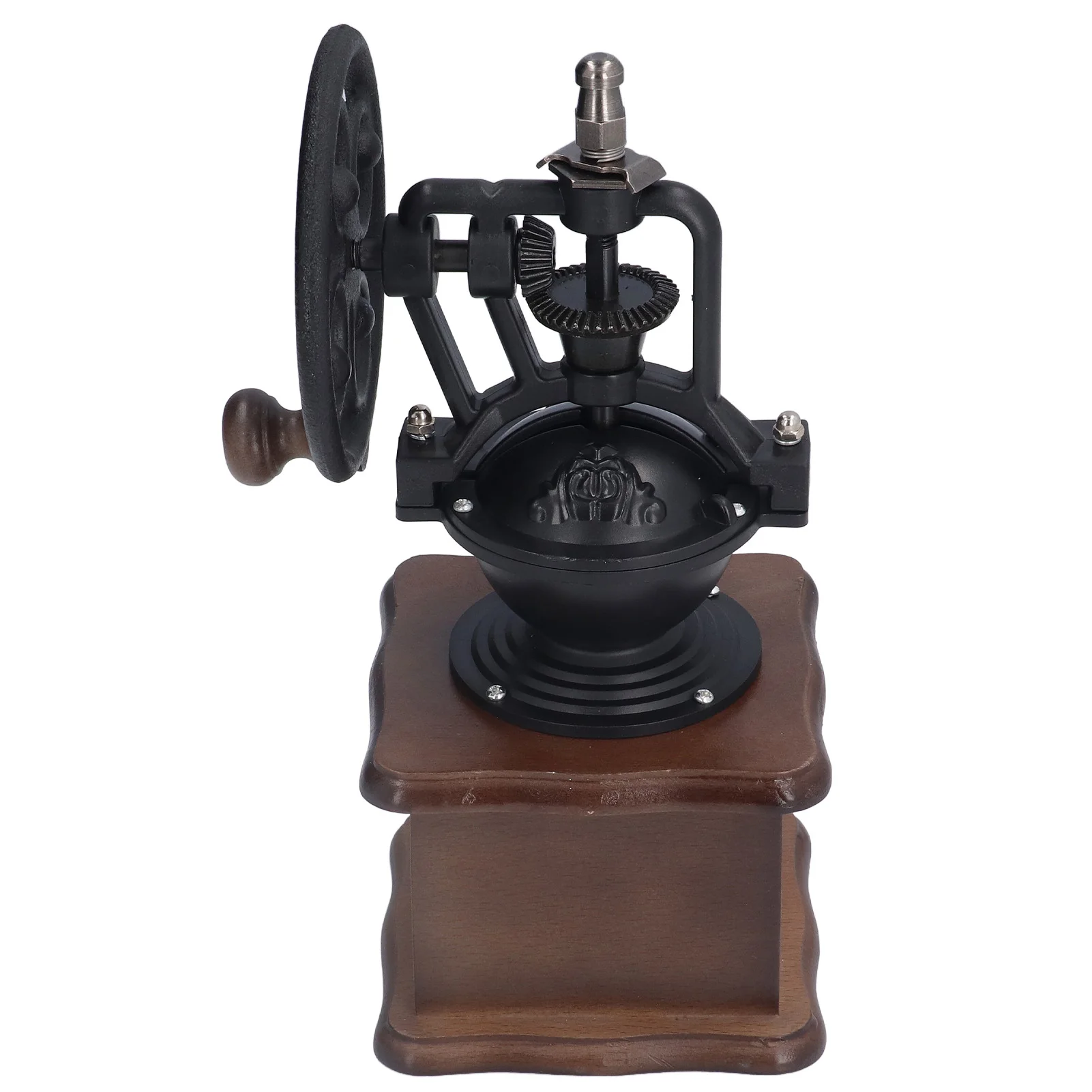
Understanding Value: Is a Premium Grinder Worth the Investment for Your Small Kitchen?
In space-constrained kitchens, every purchase represents a significant decision about space allocation. Premium grinders typically command higher prices—but their compact engineering and long-term performance often justify the investment for small kitchen users.
Value Considerations Beyond Price
When evaluating grinder investments for small spaces, several factors influence long-term value:
- Durability: Premium models average 7-10 years of regular use versus 1-3 years for budget alternatives
- Space efficiency: Higher-quality engineering often delivers more capability in smaller packages
- Performance consistency: Precision mechanisms maintain grind quality throughout their lifespan
- Versatility: Better-designed models often accommodate multiple ingredients and grinding styles
The cost-per-use calculation favors quality equipment, particularly in small kitchens where each tool must justify its footprint. A $150 grinder used daily for 8 years costs approximately 5 cents per use—a modest investment for significantly enhanced flavor.
Quality Impact on Daily Experience
In compact living environments, the user experience becomes particularly important:
- Smoother operation reduces physical effort and noise
- Consistent results eliminate waste and flavor disappointment
- Efficient designs reduce preparation time and cleanup
- Durable materials withstand the increased handling common in space-limited setups
Many small-space dwellers find that travel coffee grinders offer excellent value regardless of travel intentions, as these models are specifically engineered for maximum performance in minimal dimensions—exactly what small kitchens require.
The decision ultimately depends on your specific grinding needs and frequency. Occasional users might find budget options sufficient, while those who grind daily will experience the greatest benefit from investing in premium compact models that deliver professional-quality results without compromising precious kitchen space.
Making Your Final Decision: Finding Your Perfect Small-Space Grinding Solution
After exploring various grinder options designed for limited spaces, how do you determine which solution best fits your unique kitchen environment and culinary needs? Consider this framework to guide your final decision.
Prioritization Framework
Begin by ranking these factors based on your specific circumstances:
- Available space dimensions: Measure your intended storage location’s exact dimensions
- Primary ingredients: Coffee requires different grinding capability than spices or herbs
- Usage frequency: Daily use justifies more accessible placement and higher quality
- Noise sensitivity: Shared living spaces may necessitate quieter grinding options
- Budget allocation: Determine what percentage of your kitchen budget this tool merits
This prioritization helps narrow options to those truly suitable for your situation, ensuring you select a grinder that integrates seamlessly into your limited space.
Key Decision Questions
Ask yourself these specific questions before making your final selection:
- Will this grinder serve multiple purposes or specialize in one ingredient?
- How does the cleaning process align with my available sink and counter space?
- Does the grinder’s aesthetic complement my kitchen’s design and other equipment?
- What’s the maximum acceptable footprint for my specific space constraints?
- How important is grind consistency to my brewing or cooking results?
For many small kitchen owners, manual coffee grinders with stainless steel components offer an ideal balance of compact dimensions, straightforward maintenance, and durable performance—particularly when fresh coffee is a daily priority.
Remember that the perfect small-space grinder isn’t necessarily the smallest option available, but rather the one that delivers the optimal balance of performance, convenience, and spatial efficiency for your specific needs.
FAQs: Common Questions About Grinders for Small Kitchens
How loud are electric grinders in apartment settings?
Electric blade grinders typically produce 70-85 decibels—comparable to a vacuum cleaner—which may be problematic in apartments with thin walls. Compact burr grinders operate at 65-75 decibels, while manual grinders produce minimal noise (under 50 decibels), making them ideal for shared living environments or early morning use.
What’s the smallest drawer size that can accommodate a quality grinder?
Most premium manual grinders can fit in drawers as small as 3.5 inches (8.9 cm) in height and 3 inches (7.6 cm) in width. Look for models with detachable handles, which can reduce stored height by 30-40%. Standard kitchen drawers (4-5 inches/10-12.7 cm height) can accommodate most portable manual grinders.
Can one grinder effectively handle both coffee and spices?
While possible, dedicated grinders are preferable due to flavor transfer concerns. If space necessitates a single grinder, choose models with easily removable burr assemblies that allow thorough cleaning between uses. Ceramic burrs resist odor absorption better than steel, making them more suitable for multi-ingredient use in limited spaces.
How can I clean my grinder thoroughly with limited sink space?
Use small containers with cleaning solution rather than occupying an entire sink. Disassemble the grinder and clean components in shifts if necessary. Brushes with firm bristles require minimal water yet provide effective cleaning. For thorough burr cleaning without space-consuming soaking, use grinder cleaning tablets followed by a quick rinse of individual components.
Are compact electric grinders less powerful than full-sized models?
Compact electric models typically use motors in the 100-150 watt range versus 200-300 watts for full-sized units. While this results in slightly longer grinding times (10-15 seconds additional), quality compact models compensate with efficient design and optimized burr geometry. For most small household needs, the performance difference is negligible compared to the space savings.

